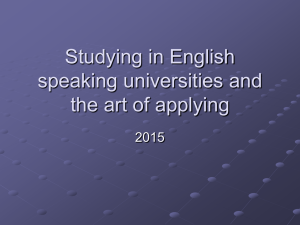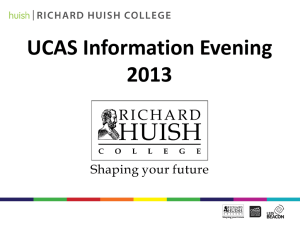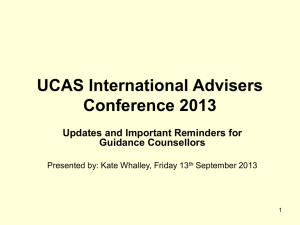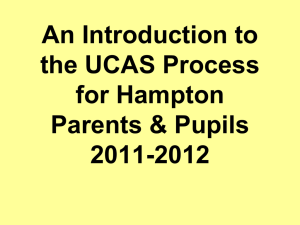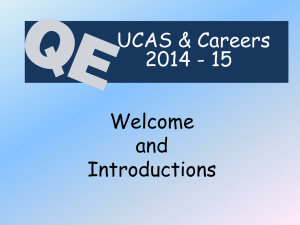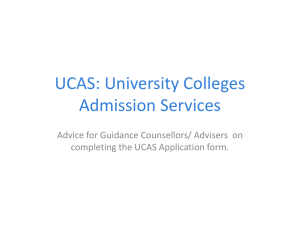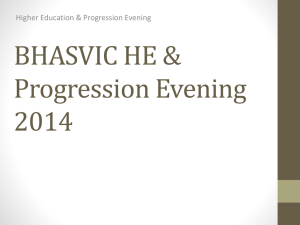Applying to UCAS - Taipei European School
advertisement
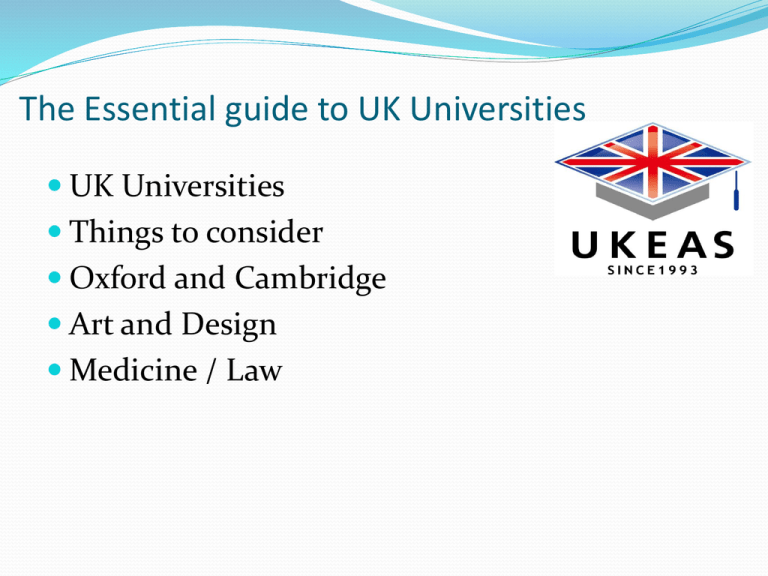
The Essential guide to UK Universities UK Universities Things to consider Oxford and Cambridge Art and Design Medicine / Law Overview of UK Universities Ancient Universities University of London (1836) Civic Redbrick Universities (Latter part of 19th Century) Plate Glass Universities (1960s) New universities (1992) What do I need to consider? What are you studying / proposing to study at HL in IB? HL courses determine types of degree courses Predicted grades? Determine the universities you can apply to be realistic as you only have 5 choices Students will do 3 HLs, university offers generally based on these. Research excellence What is the significance of these universities? Research intensive Very competitive Students need to demonstrate independence Fewer contact hours with professors How to get in? Strong academic grades Comprehensive study plan Strong reference letter Average UCAS points Value of IB scores: IB 40 = 611 UCAS points IB 39 = 589 UCAS points IB 38 = 567 UCAS points IB37 = 545 UCAS points IB 36 = 523 UCAS points IB 35 = 501 UCAS points Scores are combined with SL and HL – be realistic with your expectations, average IB score around the world has consistently been 30 for 40 years. IB score distribution Highest number of applications Applications per place LSE – 11.5 Edinburgh 8.6 St Andrews 8.4 King’s College London 7.8 Bristol 7.7 UCL 7.7 Warwick 7.4 Imperial 6.6 Oxford 5.5 Cambridge 4.7 Post 1992 Universities (Teaching Excellence) Specialise in teaching (vocational courses) Many academics have industrial or business experience More contact time with professors Research suggests that new universities are academically more effective at teaching (Quality Assurance Agency QAA) Build industry links and promote internships How to choose the right course/university? Predicted grades? (SL exams will give an idea) What do you want to study? What is more important, course or university? Choosing the right course: Use UCAS search List entrance requirements Result of UCAS search for Economics Birmingham require 38 points – minimum 665 with 6 in maths Cambridge require 39-42 points minimum 776 with 7 in maths Durham require 39 points – minimum 665 with 6 in maths Leicester require 34 points – minimum of 5 in all subjects at HL Leeds require 34 points – minimum of 5 in all subjects at HL UCL require 39 points – minimum of 766 with 7 in maths Oxford or Cambridge Can only choose one Will be expected to get highest grades possible – “If you wish to apply for an undergraduate place at Cambridge, you need to be in the top one or two per cent of your year group, and doing very well in the subject area you'd like to study.” Application deadline is 15th October Complete SAQ (supplementary application questionnaire), sent via email Attend interview English Language – Minimum of B in GCSE or 5 in SL IB Oxbridge Interviews Does this person show outstanding ability in their subject? Have they the potential to bring something new to the field? Would this person gain academically from my tuition at the college? Is this a person I would enjoy teaching? Would this person enjoy life at Oxbridge? Likely to be asked questions that need consideration. Potential tutors will want to see how you react to ideas for team work or general guidance Art and Design Programmes Specialist schools for fine art include: I. II. III. IV. V. Slade School of Art (University College London) University of the Arts, London (Central St Martins) Edinburgh School of Art (University of Edinburgh) University for the Creative Arts Glasgow School of Art Foundation programmes are not specified, but students have a better chance of acceptance at the above institutions if they have done one. Art and Design Programmes Many of the 1992 universities offer these programmes and are very good at preparing students with vocational skills. In terms of art and design, courses on offer include: Product Design Shoe / Clothing & Fashion Design Car Design Graphic Design / Computer Games Ceramics Animation / Illustration Photography / Media Art and Design deadlines I. There are two deadlines for Art and Design Programmes, 15th January and 24th March. II. You can apply for 15th January courses and 24th March courses later on same application Medicine / Dentistry Deadline 15th October You can only apply to 4 institutions, the 5th programme must be something different Applicants must take UKCAT (most common) or BMAT (Oxbridge / Imperial / UCL) – Can be done in Taiwan Medical Interview International places = 7½% of available places UKCAT and BMAT Can do once a year, check for test dates on respective websites UKCAT / BMAT test: 1. Verbal Reasoning 2. Quantitative Reasoning 3. Abstract Reasoning 4. Decision Analysis Each of the sections are marked and an average score is taken. UKCAT score up to 900 – 650+ = a competitive score. BMAT score up to 9, 5 is average, 6 is seen as competitive. Both tests are 2 hours long and multiple choice Other Tests Leading universities need the LNAT test (National Admissions Test for Law), universities include: Birmingham, Bristol, Durham, Glasgow, King’s College, Manchester, Nottingham, Oxford, UCL 2¼ hours 42 multiple choice questions - measure reading, comprehension and logical reasoning skills (Oxbridge forums state 18+ on multiple choice is good). Reading 40 minute essay question What are the best universities? There is no “best” university, they all have different missions. This is highlighted in the following that shows which universities have the best recruitment record: The University of Surrey 96.9 Harper Adams University College 96.5 The Robert Gordon University 95.9 The University of Cambridge 95.2 King's College London 94.6 Choosing a course How to choose your course: What are you interested in? If you are not sure you can check online careers guidance at http://www.fasttomato.com/ or more detailed Centigrade test (£30 for international students) http://www.coa2.co.uk/centigrade/?pagename=index Check the UCAS site for important dates (deadlines) Personal Statement – Why universities should choose you Why do you want to study the course? Can link skills/experience Check spelling and grammar Keep sentences short (12-20 words) Each sentence should add something new, not increase word count Quality of writing reflects quality of thought Don’t be too formal or familiar 80% of statement should focus on course for competitive universities Be honest – the statement can be used as basis of interview Get someone to check your statement Completing the Application Payment – £23 for 5, or £12 for one Reference Submission to UCAS UCAS EXtra If you've used all five choices and are not holding any offers, you may be able to use Extra to add another choice if: you've received decisions from all five universities or colleges, but want to change course you weren't accepted or you declined any offers you received Offers and accepting offers Conditional / Reject? Deadline to accept (set when all universities have made a decision) Accept Firm / Insurance Wait results Unconditional (?) Clearing and Adjustment Clearing Adjustment Universities know grades If you did better than before students do If grades are lower and university has not accepted you, need to go into clearing Check UCAS to see what courses are available. Contact university. Be careful, if you accept a course, cannot continue looking expected, can apply for more competitive course. Like clearing, call university and see if they accept you Won’t lose course at original firm Q&A Still confused? Need more help? Upcoming Events: October 10th: Study World, Songshan Park Eslite, Taipei New Horizon (6F) No 88 Yanchang Road, Xinyi Dist. More Information: Jack Shull – TES University & Careers Counsellor UKEAS – 3 Offices in Taipei - open for counselling from 10am to 7pm, Monday to Friday Website: www.ukeas.com.tw
